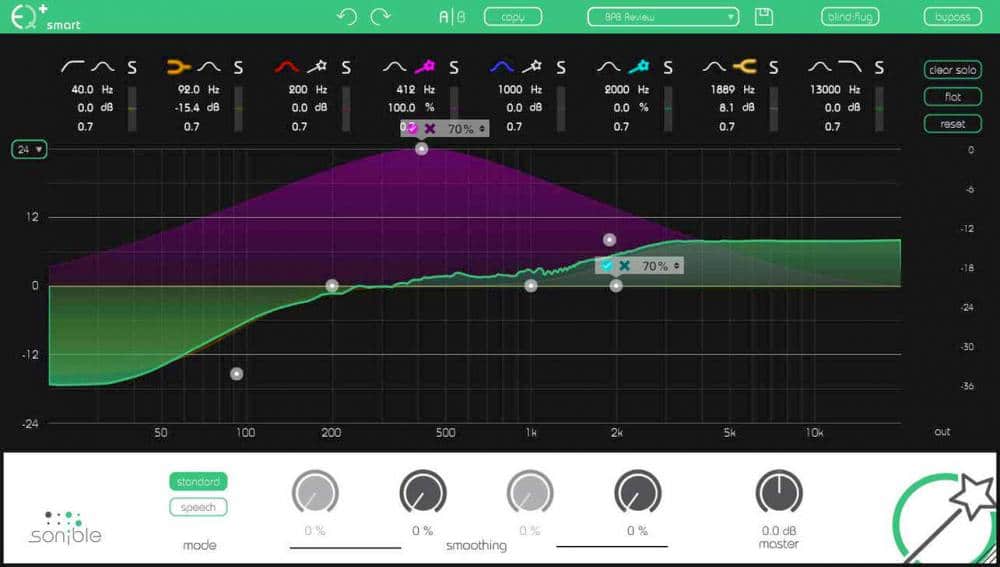Review of Sonible Smart EQ+

Do we REALLY need another EQ? We have stock eq’s, free eq’s, hardware eq’s, dynamic eq’s, analog modeled eq’s, digital eq’s that can do a zillion cool things…
I find it hard to get excited about another eq these days, unless there’s something truly new and unique it brings to the table. More developers should take advantage of the digital domain and bring fresh ideas to the table…and that’s exactly what Sonible does.
I’ll level with you. I’m a fan of this EQ. But that aside, I’m not gonna let this be an article written just to convince you to buy something. My intention is to be impartial, and I will list pros and cons of smart:EQ+. And to ensure that you know I’m leveling with you, my license is an NFR given in exchange for a review. So now that you know that, let’s dive in.
smart:EQ+ offers 4 “smart” bands, which analyze the incoming audio to recognize spectral deficiencies. The smart curve that is applied attempts to correct these deficiencies, and can be quite intricate. It’s because of this amount of detail that smart:EQ+ needs to use a bit of latency. But if you can afford the latency, it’s well worth it! After familiarizing myself with how to use the smart bands, they quickly became a favorite!
smart:EQ+ isn’t modeling anything from the analog world. There’s no noise floor, and you can’t clip the plugin internally. This is expected behavior in clean digital eq’s these days, but it’s worth noting.
My favorite use so far is as a 2 bus eq. I’ve applied a curve similar to the one Adam “Nolly” Getgood demonstrates in Creativelive’s “Studio Pass: Periphery”. In part 25, Nolly shows the eq curve he’d been mixing through as a preset on the 2 bus in a top down approach. He was using Pro-Q from fabfilter, but I was able to replicate it quite easily in smart:EQ+ without sacrificing any of the 4 smart bands. This is where it gets interesting!
Here’s a link to the preset file I made for smart:EQ+ to use on the 2 bus.
Load it on the 2 bus, then set your initial balance. From there, use the 4 smart bands to carve out mud quickly on the whole mix. This will leave you with less work to do on the individual tracks!
https://youtube.com/watch?v=kzXrwIBWnsQ%3F
Let’s dive in to the pros and cons I’ve found.
Con.
The smart bands aren’t intuitive to use for someone who has never used them before. You have to spend a moment with the manual to understand how it works, which is encouraged behavior in its own right, but not something typically needed in an EQ.
Pro.
The learning curve isn’t very steep, and once you understand how to use the smart bands you’ll find yourself using them a lot!
Con.
The manual isn’t accessible from the main GUI panel. This isn’t a problem for me, because I have a folder where I place all manuals when I install a new plugin. But with many developers including a direct path to the manual on the gui, this seems like an oversight.
Pro.
The GUI is otherwise well designed. Your eye naturally navigates the controls, and the contrasting color scheme helps keep you focused on the most important parameters.
Con.
No analyzer. Maybe an oversight? Waves F6 didn’t have an analyzer for over a year because they needed it to be zero latency, but it eventually adopted it after a high demand from users. With that being said, this eq has a LOT going on in the main eq graph panel. An analyzer may have crowded things too much, and you mix with your ears and not your eyes.
Pro.
Each band can be solo’d, and you can solo more than one band at a time! This makes up for the lack of an analyzer, because if you need to hunt down a resonance you can solo the band and sweep the spectrum to hunt it down.
Con.
This one reported 4096 samples of latency for each instance. This makes sense, because the smart algorithm needs some latency to do its thing. But the amount of latency means this is less likely a tool you’ll use when tracking and more likely to be a mixing/mastering only tool. They offer a live version, which has an analyzer and has zero latency. But that’s not included in the studio version of smart:EQ+.
Pro.
8 flexible bands gives you all the eq control you could want. Each band offers a symmetrical bell filter. Bands 1 and 8 also offer high pass and low pass filters. Bands 2 and 7 offer high shelf and low shelf filters. Bands 3 through 6 offer smart bands.
Con.
Could use automatic gain compensation, which is another feature that more and more digital eq’s are starting to include. However, much like the others, it’s not a deal breaker.
Pro.
It does include other useful features on the gui that are more modern standards. These include undo/redo, a/b comparing, a reset button, and a flat button! The flat button is one I find particularly cool, because I like to create presets of my eq moves after setting the gain to zero. This way I can use the frequency and curve type I like on similar sources, and only need to worry about the gain control to dial in the right amount. Once I know I want to make a new preset, just hitting “flat” will zero out the gain controls while leaving everything else where it is. Save that as your new preset, and you can speed up your workflow even more!
There you have it. What are your thoughts? Have you tried smart:EQ+? Were you a fan? Leave a comment below!
[amazon_link asins=’B0774YMMXL,B0774ZW44Q,B0774Y8K6W,1540024830,B0774WRNS2,B0774YZBXH,B0774ZRP5P’ template=’ProductCarousel’ store=’maasc-20′ marketplace=’US’ link_id=’948f6717-8121-11e8-8abd-47023ecfab44′]
[amazon_link asins=’B004X4Y1L8,B07CVQQRXP,B07CVPK2MG,B00KBXIOO0,B00KBXIUPS,B01NBHKSD7′ template=’ProductCarousel’ store=’maasc-20′ marketplace=’US’ link_id=’b0c451d5-8121-11e8-a917-4d4dcb590428′]
Discover more from Making A Scene!
Subscribe to get the latest posts sent to your email.












































